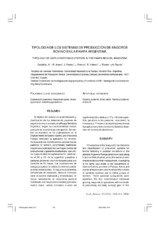Mostrar el registro sencillo del ítem
Tipología de los sistemas de producción de engorde bovino en la Pampa argentina
| dc.contributor.author | García Martínez, Antón Rafael | es_ES |
| dc.contributor.author | Pamio, J. | es_ES |
| dc.contributor.author | Valerio, Daniel | es_ES |
| dc.contributor.author | Perea Muñoz, José Manuel | es_ES |
| dc.contributor.author | Martos Peinado, José | es_ES |
| dc.contributor.author | Acero de la Cruz, Raquel | es_ES |
| dc.contributor.author | Castaldo, Ariel Osvaldo | es_ES |
| dc.date.accessioned | 2010-04-08T09:35:35Z | |
| dc.date.available | 2010-04-08T09:35:35Z | |
| dc.date.issued | 2006 | |
| dc.identifier.issn | 1885-4494 | |
| dc.identifier.uri | http://hdl.handle.net/10396/2873 | |
| dc.description.abstract | The objective of the study is the identification and classification of production systems for bovine fattening in pastoral conditions in the semiarid Argentine Pampa called invernada, taking in account their physical, productive and economic characteristics and its management. A sampling of 56 farms was made at the Department of Quemú-Quemú, province of Pampa. Anova and cluster analysis were used to reduce the number of variables involved and to define groups of farmers. Three pastoral subsystems were identified; the first, denominated traditional grazing, responds to operations with low levels of productivity and daily average gain. In this system the 56 percent of surface were perennial pastures and the invernada lasteds for 23 months. This group of operations applies the criterion of minimum cost in the decision making. The second subsystem, denominated of transition marks the evolution between the traditional system and the technified one. The third subsystem is deno-minated technified grazing and shows greater levels of productivity and daily average gain; the farms use greater levels of feed and the 77 percent of the surface were pastures, and the invernada is finalized in 17 months. These operations apply the maximum benefits criterion in the decision making. | en |
| dc.description.abstract | El objetivo del estudio es la identificación y clasificación de los sistemas de pastoreo de engorde bovino invernada, en la Pampa Semiárida Argentina, según sus características físicas, productivas, económicas y de gestión. Se realizó un muestreo de 56 explotaciones en el Departamento de Quemú-Quemú, provincia de la Pampa. Mediante la aplicación de técnicas multivariantes se identifican tres subsistemas de pastoreo. El primero, denominado tradicional, responde a explotaciones con bajos niveles de productividad y ganancia media diaria, que utilizan bajos niveles de suplementación, destinando el 56 p.100 de la superficie ganadera a pasturas perennes y la invernada muestra una duración de 23 meses. Las explotaciones de este grupo aplican un criterio de mínimo coste en la toma de decisiones. El segundo subsistema, denominado de transición, marca la evolución entre el sistema tradicional y el tecnificado. El tercer subsistema se denomina pastoril tecnificado; con mayor productividad y ganancia media diaria, utiliza elevados niveles de suplementación y dedica un 77 p.100 de la superficie ganadera a las pasturas, reduciendo la invernada a 17 meses. Las explotaciones de este tipo aplican un criterio de máximo beneficio financiero en la toma de decisiones. | es_ES |
| dc.format.mimetype | application/pdf | es_ES |
| dc.language.iso | spa | es_ES |
| dc.publisher | Universidad de Córdoba, Servicio de Publicaciones | es_ES |
| dc.rights | https://creativecommons.org/licenses/by-nc-nd/4.0/ | es_ES |
| dc.source | Archivos de zootecnia 55 (210), 183-193 (2006) | es_ES |
| dc.subject | Sistemas de pastoreo | es_ES |
| dc.subject | Vacuno de carne | es_ES |
| dc.title | Tipología de los sistemas de producción de engorde bovino en la Pampa argentina | es_ES |
| dc.title.alternative | Typology of cattle fattening systems in the Pampa region, Argentine | en |
| dc.type | info:eu-repo/semantics/article | es_ES |
| dc.relation.publisherversion | http://www.uco.es/organiza/servicios/publica/az/az.htm | es_ES |
| dc.rights.accessRights | info:eu-repo/semantics/openAccess | es_ES |

